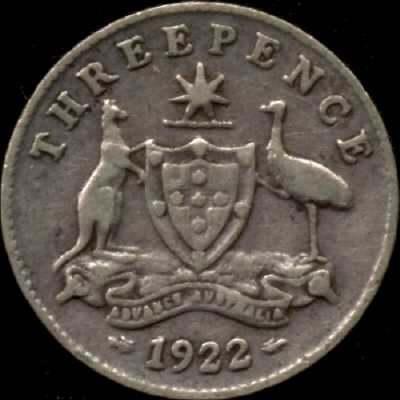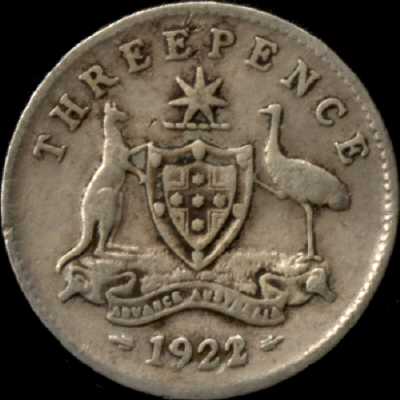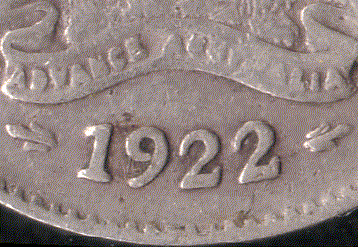
Standard issue.

Overdate. Approximately 800 specimens thought to exist.
|
|
|
Designation |
T22M |
|
Mint |
Melbourne |
|
Mint mark |
None |
|
Mintage |
5,530,000 |
|
Diameter |
16mm (5/8") |
|
Weight |
1.41g (1/20 oz) |
|
Composition |
Ag 92.5%, Cu 7.5% |
There is one well-known variety of the 1922 threepence, the 22/1 overdate.
 |
T22M.2A.1 Standard issue. |
 |
T22M.2A.2 Overdate. Approximately 800 specimens thought to exist. |
In a discussion of overdates starting on page 19 of their book16,
Myatt and Hanley state that in 1969 the Royal Australian Mint superimposed photographs
of 1921 and 1922 threepences to produce a composite image which was significantly
different from the supposed overdate. Furthermore, since two master punches for
1922 had been supplied by the Royal Mint in January 1922, there had been no imperative
for the Melbourne Mint to engage in a redating exercise. The conclusion offered
by the R.A.M. was that the 22/1 threepence is the result of chipping of the die
surface under pressure.
This explanation has not been accepted by the numismatic community. The Melbourne
mint die records do confirm the receipt of 1922 tools but the issue is not exactly
clear. On 11/1/22 in a new die account book started that year the Melbourne mint
recorded four 1921 threepenny reverse dies in stock and an entry for 31/1/22 shows
five 1922 threepenny reverses. Interestingly, the 31/1/22 entry was made after two
entries for February. The date on the first February entry is illegible but if I
were to guess I'd say it was 7/2/22. The second entry is for 13/2/22.
About all we get from this concerning the 1922 threepenny reverse is that the Melbourne Mint had five in stock at the end of January 1922, presumably pressed from a hub which had been received from London at some earlier time. This lends support to the RAM claim that the Melbourne Mint had no need of redating.
Workshops Die Account Date No of
blanks
1st blow
diesDescription
4 Jan 3 Obv 3d
3 Rev 3d (1921)
16 Jan 4 Penny rev for Perth (1921)
11 Jan 4 Obv 3d
4 Rev 3d (1921)
? Feb 10 Rev penny dies for Perth (1922)
13 Feb 10 Rev shilling dies 1922 - London punch
31 Jan 5 Obv 3d
5 Rev 3d (1922)
12 Rev 1d (1922)
? Feb 5 Obv 1d
5 Rev 1d (1921)
If, despite the RAM findings, the overdate is genuine then there are at least
two plausible explanations. The first possibility is that an engraver or technician
at the Melbourne mint may have manually overpunched a 2 onto an annealed 1921 working
die; the second is that a 1921 die was hobbed with a 1922 punch. In either case,
the 1921 die would have to have been one without the M mint mark. In an article
published in the September 2003 issue of Australasian Coin and Banknote magazine33
I argue that the first of these explanations is probably correct, i.e. that the
1922/1 threepence is a genuine overdate produced by hand-stamping a 2 onto one of
the seven 1921 reverse dies in stock in mid-January 1922, perhaps as an experiment
to test the possibility of using some of the newly-pressed but obsolete reverse
dies.
 |
This shows the relationship between the date on an ordinary 1922 threepence and
that on a 1922/1 overdate threepence. Note that the dates are identical within the
limits of the display method. This supports the idea that the overdate threepence
may have been produced by hobbing a 1921 working die with a 1922 punch but doesn't
rule out the manual overpunch explanation. |
 |
This image is an attempt to show the position of the 1 on a 1921 threepence compared
with the underdate on a 1922/1 threepence. This was the technique used by the Royal
Australian Mint to refute the overdate. This picture, like the one produced by the
R.A.M., is not particularly convincing. |